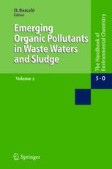Search
Search Results
-
Recalcitrant dissolved organic matter in lakes: a critical but neglected carbon sink
Lakes are hotspots for the biogeochemical processing of carbon, including dissolved organic matter (DOM). A less degradable fraction of DOM,...

-
Oxygen consumption and formation of recalcitrant organic carbon from the decomposition of free-floating macrophyte leachates
Aquatic macrophytes contain high levels of hydrosoluble compounds. These compounds disproportionately support microbial breakdown and affect...

-
Microbial consortia degrade several widely used organic UV filters, but a number of hydrophobic filters remain recalcitrant to biodegradation
Organic UV filters are important ingredients in many personal care products, including sunscreens. Evaluating the biodegradability of organic UV...

-
Seven-year experimental warming decreases labile but not recalcitrant soil organic carbon fractions in a coastal wetland
PurposeThe response of soil organic carbon (SOC) fractions to climate warming plays an important role in influencing the fate of soil C stocks....

-
Modeling adsorption and photocatalytic treatment of recalcitrant contaminant on multi-walled carbon/TiO2 nanocomposite
A nanocomposite photocatalyst consisting of titanium dioxide (TiO 2 ) supported on multiwalled carbon nanotubes (MWCNTs) has been successfully prepared...

-
Solar photo-oxidation of recalcitrant industrial wastewater: a review
Conventional methods to clean wastewater actually lead to incomplete treatments, calling for advanced technologies to degrade recalcitrant...

-
Bacterial enzymatic degradation of recalcitrant organic pollutants: catabolic pathways and genetic regulations
Contamination of soil and natural water bodies driven by increased organic pollutants remains a universal concern. Naturally, organic pollutants...

-
Bioremediation of Chlorinated Compounds
Environmental contamination by various emerging organic and inorganic pollutants has become an issue of global concern in recent times. Amongst the...
-
Organic Compounds in Paper Mill Wastewaters
This chapter is focused on the problem caused by the effluent discharges from paper and pulp mills. At present, three aspects should be considered in...
-
A review on sustainable management of biomass: physicochemical modification and its application for the removal of recalcitrant pollutants—challenges, opportunities, and future directions
Adsorption is one of the most efficient methods for remediating industrial recalcitrant wastewater due to its simple design and low investment cost....

-
Realistic Approach for Bioremediation of Heterogeneous Recalcitrant Compounds
Rapid industrialization and urbanization over the past few decades has resulted in the massive contamination of the environmental resources such as...
-
Microbial degradation of recalcitrant pesticides: a review
Some pesticides such as organochlorines are of critical environmental concern because they are highly persistent due to their stable chemical nature....

-
Remediation of recalcitrant pollutants in water solution using visible light responsive cerium-doped tungsten trioxide nanoparticles
In order to attain a solar energy-driven photocatalyst for wastewater remediation, cerium-doped WO 3 (W 1-x Ce x O 3 with x = 0, 0.02, 0.04, 0.06, and...

-
Different advanced oxidation processes for the abatement of pharmaceutical compounds
In the past two decades, with advancements in the detection technologies, researchers have shown concern over the detection of pharmaceuticals in...

-
Using textile industrial sludge, sewage wastewater, and sewage sludge as inoculum to degrade recalcitrant textile dyes in a co-composting process: an assessment of biodegradation efficiency and compost phytotoxicity
Recalcitrant dyes found in textile wastewater represent a threat for sustainable textile production due to their resistance to conventional...

-
Nanotechnological Interventions in the Degradation of Pharmaceutical Compounds
The modernization and advancements in the therapeutic field have led to the increased utilization of complex pharmaceuticals in the day to day life....
-
Nanoelectrocatalysts-Enhanced Methods for Removal of Volatile Organic Compounds in Wastewater
The degradation by biological processes of a large majority of organic volatile contaminants in wastewater is limited. This is so, largely because...
-
Biodegradation of pharmaceutical compounds in industrial wastewater using biological treatment: a comprehensive overview
The indirect ingestion of pharmaceuticals in water has been proven to have adverse effects on humans according to a number of studies. Pharmaceutical...

-
Detection of Pharmaceutically Active Compounds in Tap Water Samples by Direct Injection HPLC/MS-MS: A Danger Signal in Deficiency in Residue Management
To date, there is an increased risk to public health and the environment due to the presence of pharmaceutically active compounds within drinking...

-
Advanced oxidation process: a sustainable technology for treating refractory organic compounds present in industrial wastewater
The world faces tremendous challenges and environmental crises due to the rising strength of wastewater. The conventional technologies fail to...

